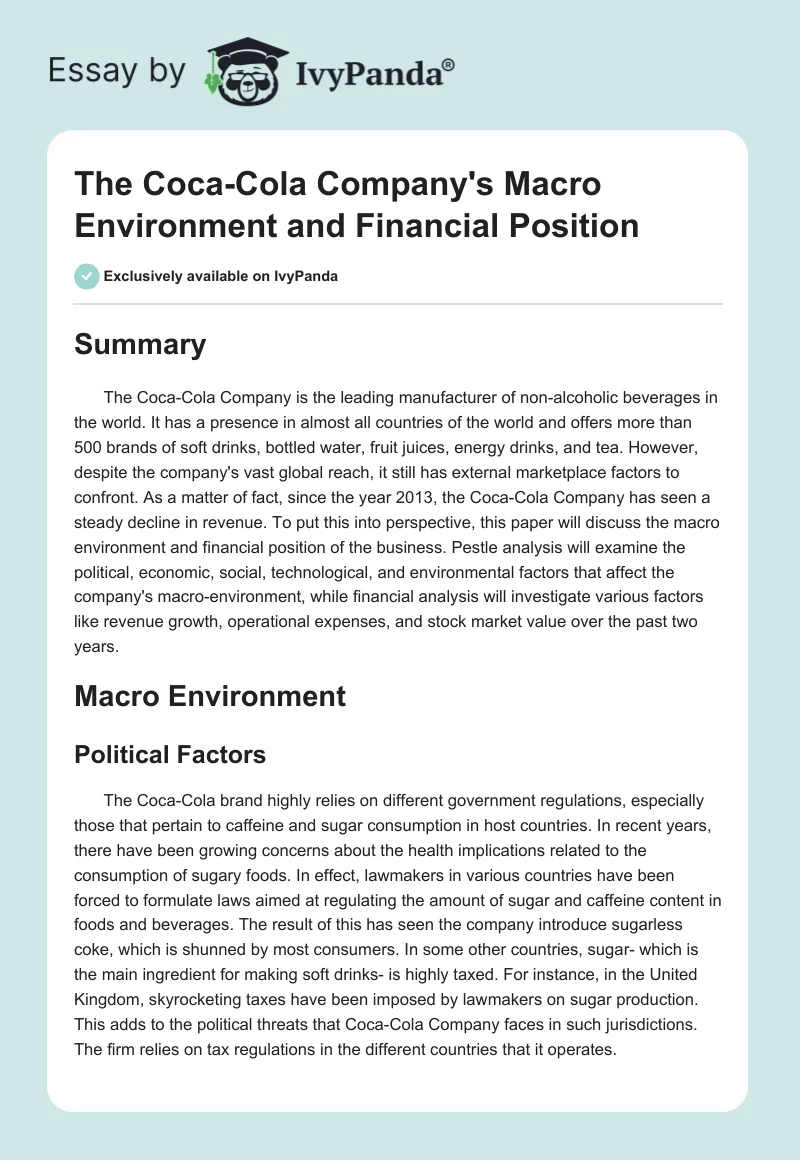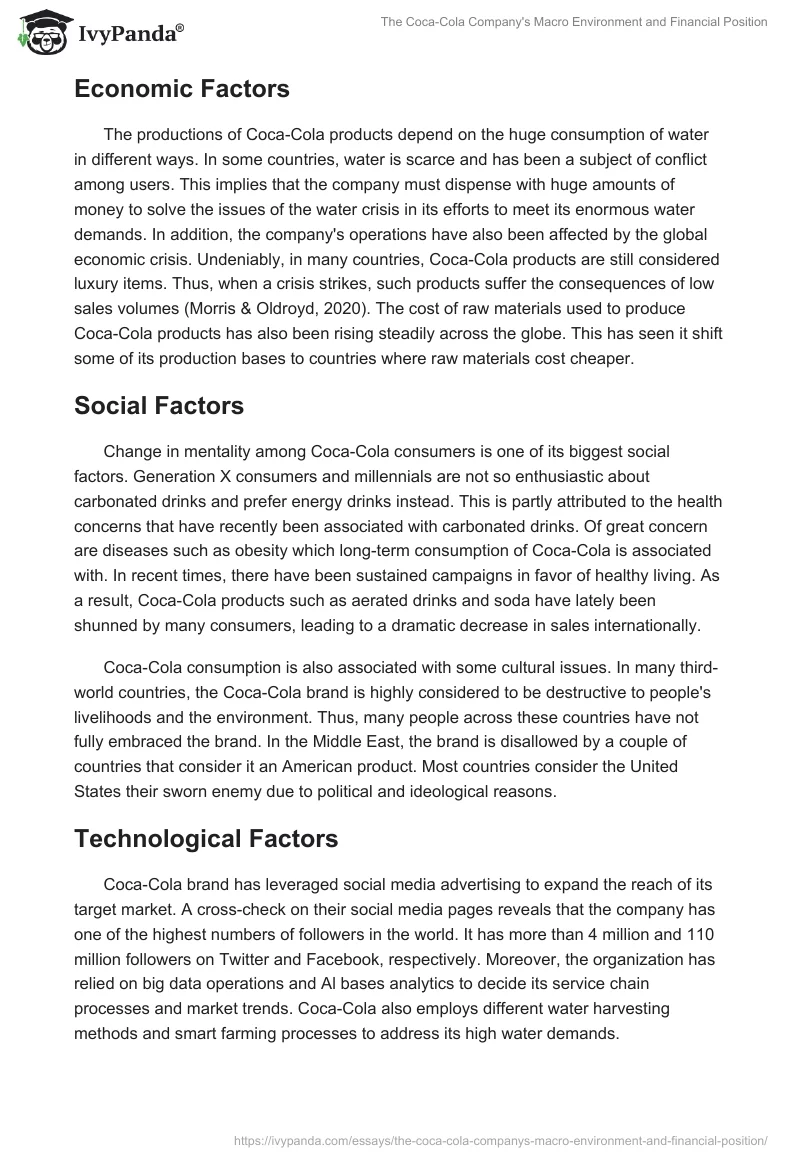Summary
The Coca-Cola Company is the leading manufacturer of non-alcoholic beverages in the world. It has a presence in almost all countries of the world and offers more than 500 brands of soft drinks, bottled water, fruit juices, energy drinks, and tea. However, despite the company’s vast global reach, it still has external marketplace factors to confront.
As a matter of fact, since the year 2013, the Coca-Cola Company has seen a steady decline in revenue. To put this into perspective, this paper will discuss the macro environment and financial position of the business. Pestle analysis will examine the political, economic, social, technological, and environmental factors that affect the company’s macro-environment, while financial analysis will investigate various factors like revenue growth, operational expenses, and stock market value over the past two years.
Macro Environment
Political Factors
The Coca-Cola brand highly relies on different government regulations, especially those that pertain to caffeine and sugar consumption in host countries. In recent years, there have been growing concerns about the health implications related to the consumption of sugary foods. In effect, lawmakers in various countries have been forced to formulate laws aimed at regulating the amount of sugar and caffeine content in foods and beverages. The result of this has seen the company introduce sugarless coke, which is shunned by most consumers.
In some other countries, sugar- which is the main ingredient for making soft drinks- is highly taxed. For instance, in the United Kingdom, skyrocketing taxes have been imposed by lawmakers on sugar production. This adds to the political threats that Coca-Cola Company faces in such jurisdictions. The firm relies on tax regulations in the different countries that it operates.
Economic Factors
The productions of Coca-Cola products depend on the huge consumption of water in different ways. In some countries, water is scarce and has been a subject of conflict among users. This implies that the company must dispense with huge amounts of money to solve the issues of the water crisis in its efforts to meet its enormous water demands. In addition, the company’s operations have also been affected by the global economic crisis.
Undeniably, in many countries, Coca-Cola products are still considered luxury items. Thus, when a crisis strikes, such products suffer the consequences of low sales volumes (Morris & Oldroyd, 2020). The cost of raw materials used to produce Coca-Cola products has also been rising steadily across the globe. This has seen it shift some of its production bases to countries where raw materials cost cheaper.
Social Factors
Change in mentality among Coca-Cola consumers is one of its biggest social factors. Generation X consumers and millennials are not so enthusiastic about carbonated drinks and prefer energy drinks instead. This is partly attributed to the health concerns that have recently been associated with carbonated drinks. Of great concern are diseases such as obesity which long-term consumption of Coca-Cola is associated with. In recent times, there have been sustained campaigns in favor of healthy living. As a result, Coca-Cola products such as aerated drinks and soda have lately been shunned by many consumers, leading to a dramatic decrease in sales internationally.
Coca-Cola consumption is also associated with some cultural issues. In many third-world countries, the Coca-Cola brand is highly considered to be destructive to people’s livelihoods and the environment. Thus, many people across these countries have not fully embraced the brand. In the Middle East, the brand is disallowed by a couple of countries that consider it an American product. Most countries consider the United States their sworn enemy due to political and ideological reasons.
Technological Factors
Coca-Cola brand has leveraged social media advertising to expand the reach of its target market. A cross-check on their social media pages reveals that the company has one of the highest numbers of followers in the world. It has more than 4 million and 110 million followers on Twitter and Facebook, respectively. Moreover, the organization has relied on big data operations and Al bases analytics to decide its service chain processes and market trends. Coca-Cola also employs different water harvesting methods and smart farming processes to address its high water demands.
Environmental Factors
The Coca-Cola Company is undoubtedly the biggest freshwater consumer in the whole world. This has put it at the receiving end of various environmental advocacy groups. In India, for instance, the company is solely held responsible for draining off groundwater resources in several areas. It has, thus, faced the threat of being banned from the country and several others (Siegfried, 2021). In effect, it has introduced smart water farming methods like CARE and RAIN that tend to limit water usage and maximize its water harvests.
Financial Analysis
Revenue Growth
Revenue refers to the amount of money that Coca-Cola receives from its customers after selling its products to them. Over the past two years, Coca-Cola Company’s net revenues grew by 16% to $37.3 billion. This growth in revenue was attributed to 2% concentrated sales growth. For the quarter ending September 30, 2021, Coca-Cola’s revenue increased by 16.07% to $10.04 billion. However, for the 12 months that ended on September 30, 2021, the revenue increased by 12.94% to $37.802 billion. The company’s annual revenue for 2020 recorded an 11.41% decline from 2019 to $33.014 billion.
Operational Expenses
Coca-Cola Company’s operating expenses for September 30, 2021, quarter amounted to $7.144 billion. This represented an increase of 12.43%. On the other hand, the company’s operating expenses for the last year, which ended on September 30, 2021, were $26.828 billion. This represents an 8.84% increase from the previous year. However, the company’s annual operating expense for the year 2020 was 24.0177 billion, which was 11.63%.
Profit Margin
Coca-Cola’s profit margin refers to the revenue percentage it retains after reducing its income. As of September 30, 2021, Coca-Cola’s net profit margin over the past two years was 23.2%. Like many businesses across the globe, the Coca-Cola Company was affected by the ongoing COVID-19 pandemic, which drastically reduced its profit margins. This is mainly attributed to the disruption of its supply chain management processes.
Stock Performance
The stock performance of Coca-Cola company can be measured against various indices such as the NYSE composite index. Over the last two years, the company’s stock performance has been 8.36% against NYSE’s 8.06%. On March 16, 2020, the Coca-Cola stock opened at 42.24 and closed at 45.26, making a gain of 7.15%. However, on March 20, 2020, it opened at 41.95 and closed at 38.3, making a loss of -8.70%.
Latest Market Value
Coca-Cola’s market value is measured using the P/Earnings NTM multiple (Price to Earnings), which refers to the current market expectations’ share price. Coca-Cola uses this to compare its market value against its earnings. As compared to its peers’ median, Coca-Cola’s P/Earnings NTM ratio is significantly higher at around 19:00. Based on these metrics, the valuation of Coca is above the current market value. As of October 29, 2021, Coca-Cola’s market value stood at 56.39 +0.02 (+0.04%).
Debt
Over the last few years, Coca-Cola has witnessed a steady increase in its debt ceiling. In the last two years, the company has accrued a total annual debt regression line of approximately $500 million geometric means. In 2020, the company’s consolidated income stood at 209.41 million. Before taxes and interest, Coca-Cola’s current earnings are expected to increase to approximately $332.7 million while its gross profit declines to around $1.7 billion (Coca-Cola Company Statistics and Facts, 2021). In 2020, Coca-Cola’s debt stood at $1.3 billion; in 2021, the figure is $1.2 billion.
Cash Position
Coca-Cola’s cash position took a hit from the effects of COVID-19 over the last two years. As of July 02, 2021, Coca-Cola’s consolidated net income was $4,879. This was an improvement from last year’s $4,554. Its depreciation and amortization were $749 million, while its expenses based on stock compensation were $148 million. It also registered $500 million in deferred income taxes.
Liquidity Measurement Ratios
Coca-Cola’s liquidity ratio measurements refer to its capability to attain its short-term obligations. They comprise of current ratio, quick ratio, and cash ratio. Coca-Cola a’s current ratio registered a deterioration between 2018 and 2019, but this improved between 2019 to 2020 (Analysis of Liquidity Ratios, 2021). The quick ratio and the cash ratio also underwent similar experiences.
References
Analysis of liquidity ratios. (2021). Stock Analysis on Net.
Coca-Cola company statistics and facts. (2021).
Morris, S., & Oldroyd, J. (2020). International business. Hoboken Wiley.
Siegfried, P. (2021). Business management case studies Pran-RFL, Netflix, McDonald’s, Google, Tesco, Apple, Coca-Cola, PSA Group, Mercedes, Tesla, Toyota, Beximco, KFC, LBC Lao Brewery Company. Books on Demand.


